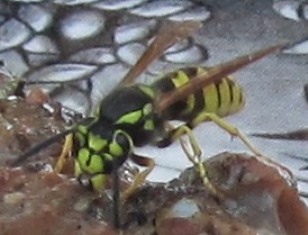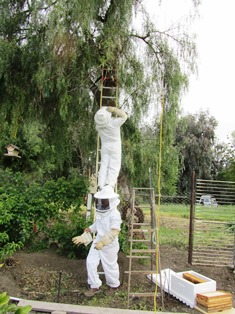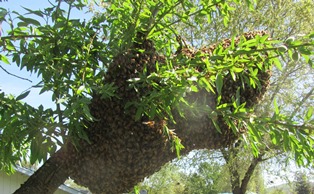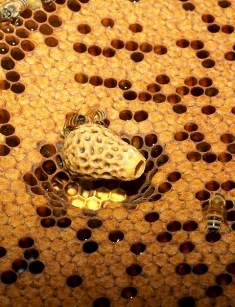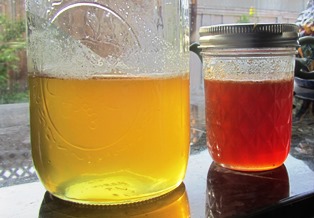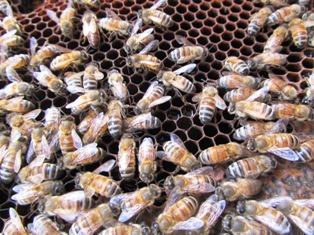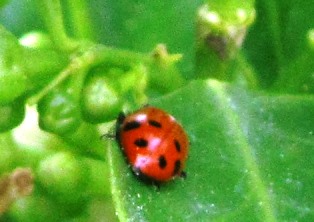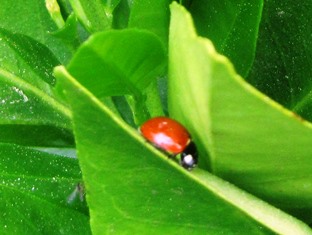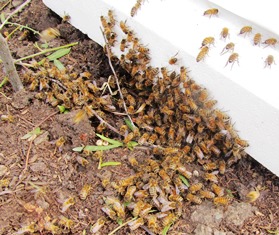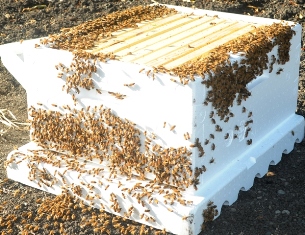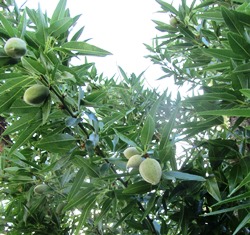Archive for the 'Insects' Category
An Unwelcome Visitor for Brunch
I welcome visits into my yard by honey bees–they are not interested in me or my plate of food (unless it has honey on it), but hornets, wasps, and yellow jackets are not welcome.
This past Sunday morning, I was enjoying a plate of food on my patio when a yellow jacket made an unwelcome appearance. These are the yellow and black predatory wasps you find on your soda cans and sweets at picnics. Some people call them “meat bees” but they are actually wasps.
What value are they to gardens, you might wonder. I did. Although I loathe them, I did a little research and discovered that yellow jackets are predators of insects that many of us gardeners consider pests. But try as I might, I just can’t make myself like yellow jackets. The females don’t just sting and die. They can sting multiple times. And wasp stings hurt.
About those stingers–they are like lances with barbs, injecting venom into you during a sting. The stings are not dangerous unless you happen to be stung repeatedly or you are allergic to bee and wasp stings. In that case, you might carry a epinephrine autoinjector (known as an EpiPen) in the event of a life-threatening sting to treat anaphylaxis.
Keep a lookout for yellow jackets in the spring when the queen seeks a place to construct a paper nest. These wasps (related to hornets) live in social colonies with female queens and workers, and also males, known as drones. They like to establish their nests in hollowed logs and human structures (like houses with holes for entry into attics or walls). They enjoy a diet rich in sugar and carbohydrates. Don’t we all? But take care when enjoying your al fresco Sunday brunch. You never know who might drop in!
Attracting Butterflies into Your Garden
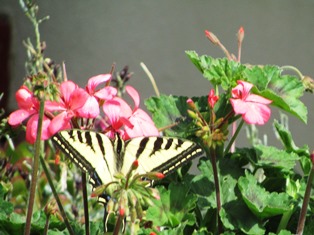
The Western Tiger Swallowtail, shown here on geraniums, resembles its counterpart, the Eastern Tiger Swallowtail
While sipping my morning coffee today, I spotted a Western Tiger Swallowtail butterfly in my garden. So naturally, I had to put down my mug of coffee and grab my camera.
These beauties have wingspans stretching up to four inches. The butterflies are often seen in woodlands around streams and riverbanks or canyons in the west. For a complete list of butterflies for Northern California, see http://www.thebutterflysite.com/california-butterflies.shtml
Here on the farmette, these beautiful butterflies feed on the nectar of the garden plants. I often see them on the blooms of my hedge of lavender and elsewhere on the zinnias. They also flit over and and perched on the water fountain near where I grow roses and wisteria.
You can attract these particular butterflies into your Northern California gardens by planting petunia, Mexican sunflower, dianthus, and the butterfly bush. But do a little research on creating a butterfly garden if you want to attract different types of butterflies. And don’t use pesticides or insecticides if you are serious about creating such a haven.
A Swarm in July Isn’t Worth a Fly
There’s an old proverb about bees that goes: A swarm in May is worth a load of hay, a swarm in June is worth a silver spoon, but a swarm in July isn’t worth a fly. You might wonder why.
Well, I asked my beekeeper neighbor that question this morning as we suited up to feed the bees and take some frames of honey. The hives were thriving, bees were active, and the honey production copious. He harvested some, but also left some for the babies that the queen had produced.
There are spring flowers in May and new flowers in June, but by July many of the flowers that the bees love to forage on have flowered and gone to seed. If the queen lays lots of babies, where will the worker bees get enough pollen and nectar to support the entire hive, feed the queen, and supply the babies?
During fall in Northern California, the bees can forage on the eucalyptus blossoms, but then, they must survive through winter. I see bees on my December roses, but there aren’t a lot of flowers blooming in December that have high pollen and nectar loved by the bees.
Swarming in May and June is a sight to behold. Swarming is way the bees of deal with hive/nest overcrowding. It is how they increase their populations. See, http://entomology.unl.edu/beekpg/beeswarm.shtml.
A savvy beekeeper is ready to capture swarms as soon as the weather warms up in late spring. The bees won’t wait, although it is possible for a seasoned beekeeper to anticipate a swarm and take action to avert it. But it doesn’t always work.
An apiarist must manage his or her colony of hives and anticipate the needs and activities of the bees for the coming season–at this time of year, that means during fall and winter. Without a lot of food growing to support a new hive of bees from a captured swarm, a swarm in July isn’t worth a fly.
Honeybees Have Distinct Personalities
I don’t wear perfume in the garden least the bees think I’m a flower and light on me. But if they do, I let them walk around and explore. I don’t swat at them. Why would I? Honeybees are generally among the most docile of all bees.
Honeybees also have different personality types, according to research published in 2012 in the magazine Science and based on a study by Gene Robinson, University of Illinois entomology professor and director of the Institute for Genomic Biology. See, http://news.illinois.edu/news/12/0308bees_GeneRobinson.html
Scavenging and reconnaissance work carries more risk and challenge, whether you are human or honeybee. An adventuresome personality is usually best suited for that kind of work. Robinson and his researchers observed that the honeybees that do the nest and food scouting express distinct patterns of gene activity in molecular pathways that have been associated with thrill-seeking.
Whereas the adventurous scouts choose the thrill of taking off, the more intrepid and timid bees tend to stick closer to home, doing the tasks of building the hive, cleaning it, caring for the babies, and making honey. Robinson’s research debunks the ages-old idea that the colony’s workers are interchangeable.
America’s first honeybees arrived in from Europe by ship to the American colonies in the 17th century. It took approximately 200 years for the honeybees to get to the West Coast from that early introduction. Some went feral. See, http://www.orsba.org/htdocs/download/Honey%20Bees%20Across%20America.html
The most aggressive honeybee personality is the Africanized bee (aka, killer bees). These bees attack (often in droves) if they perceive a threat to their nest or queen. See, http://www.independent.ie/world-news/americas/couple-attacked-by-swarm-of-30000-bees-who-kill-their-two-horses-29456104.html
The Africanized bees have spread from Brazil, where honeybees from Europe (highly valued for pollinating crops and producing honey) were interbred with bees from Africa. These bees were inadvertently released in the 1950’s in Brazil and began to migrate north. They are now in Texas, New Mexico, Nevada, Arizona, and California. See, http://bees.ucr.edu/ahb-facts.html
All this information about work and personality types as it relates to honeybees makes me wonder: If we humans suited our work to our personality types, would we work as contentedly as do the bees in the garden and those in the hive?
Paper Wasps Under the Eaves
The small, yellow-striped paper wasps have built two nests under the eaves. These insects are considered agriculturally beneficial, but they tend to get a little too close for comfort. The nests are right above my front door.
The nests are open-cell structures held together by fibers that the queen has masticated from wood posts (and sometimes woody plant stems) and mixed with saliva to create the cells of the nest. The nest can be grow to six to eight inches across in order to accommodate a growing population.
Paper wasps feed their offspring caterpillars, beetle larvae, corn earworms, flies, tobacco hornworms, armyworms, and other insects.
These wasps can sting multiple times, unlike the gentle honeybee that can sting only once. Earlier this year, when we were working on our front windows and door, I was stung four times on my cheek. For people allergic to bee stings, the sting can be life-threatening. It’s recommended to wear a bee suit when removing the nest as the wasps will attack in response to the threat to their nest.
The best time to remove the nest is evening when the wasps are less active and on the nest. High pressure water can be used to knock down the nest. I wrapped a hand towel saturated with a strongly scented kitchen cleaner. I took the nests down and then quickly went back into the house. The next day, a random paper wasp was back, apparently ready to rebuild. What was I to do, but reapply the smelling kitchen cleaner. The wasps are gone now.
Honeybee Disorders and Diseases
The beleaguered honeybee is threatened from environmental stresses, pests, and diseases that not only can decimate the bees but continually challenge modern beekeepers who must figure out how best to treat the problems.
Beekeepers against the use of chemicals within the hive believe there are other options available for dealing with these challenges such as breeding stronger, more resistant bees. That can take years. Meanwhile, it is important to understand some of the problems that can assail a hive.
Chalkbrood
When you see a frame within the hive containing larvae that have turned chalky white, consider that you are likely dealing with chalkbrood. Infection is by a fungus, Ascosphaera apis, causing the larva to die after its cell has been capped. Only the larvae are susceptible. Healthy hives of bees can usually clean up the problem on their own. Re-queening the hive and rotating out the old comb comprise the best course of treatment.
Nosema
Nosema cerrane is a fungus infection of the adult bee, affecting the intestinal tract that results in diarrhea. The disease can weaken the bees and diminish the health of a hive. Heathy hives can usually fend off and recover from Nosema, but hives that are already week are more susceptible to Nosema infection.
Tracheal Mites
Tracheal mites infect the trachea (windpipe) of honeybees. Look for extended wings (when infected, bees are not able to fold their wings against their abdomens); missing wings, and dead bees on the ground outside of the hive.
Treatment consists of placing menthol crystals in the hive and leaving them for 14 days when temperatures at at 60 to 80 degrees Fahrenheit. The bees breathe in the menthol and mites die. Honey from medicated hives should not be consumed; frames for honey (for human consumption) can be put into the hive three to four weeks after medication is removed.
Alternatively, some beekeepers advocate using solid vegetable shortening and sugar patties, believing the bees eat the sugar and the shortening gets on their bodies making it difficult for mites to reproduce or attach to bees. A commercially available product Apiguard is also effective but must be used as directed. Do not treat when honey flow is on.
Most articles about treating bees with medications also warn that such treatments will contaminate the honey for human consumption and suggest treating bee colonies during certain times of the year, not treating during honey flows. Beekeepers are always advised to use medications according to instructions that come with them.
Varroa Mites
This external parasite of honeybees showed up in hives in the United States around 1980. Facing little resistance from American honeybees, it attacked adult and larvae, preferring drone (male) larvae to worker bee larvae. In addition to the mite’s direct attack on bees, it serves as a transmittor for viruses that can infect bees.
Treatment varies. One is to finely dust powdered sugar onto all the bees so the mite can no longer ling to the bees. Thus losing their grip, they fall off. Another treatment is to insert drone (male bee) comb. The mites prefer the drone larvae ( larger and develop over a longer period).
Once the mites infect the drone larvae, the drone comb is removed and put into a freezer, killing the mites. After a period of freezing, unseal the comb, return to the hive, and healthy worker bees will clean it.
Bee genetics might prove to be effective in the long run for dealing with the dreaded varroa mite. In the Primorsky region of Russia, a strain of bees have been found to be more than twice as tolerant to the varroa mite as conventional bee stocks and also more resistance to the tracheal mite. So after a period of quarantine, these Russian bees are available for commercial purpose in the United States.
Beekeepers can also control populations of mites using miticidal strips. These are hung inside the hive and must be handled and disposed of as hazardous material. Unfortunately, the mites are developing increasing resistance to the chemicals in miticides.
Foulbrood
The spore-forming bacterium Bacillus larvae is the most dreaded perhaps of all bee brood diseases–American foulbrood. European foulbrood is another brood disease of such highly infectious nature as to require the burning of the hive.
In American foulbrood, the bacterium infects larvae up to three days old producing millions of spores. Some bees are more susceptible to this highly communicable disease than others.
Teramycin (oxytetracycline) is the only drug approved to treat American Foulbrood Disorder. Many beekeepers use this drug annually as a prophylactic treatment for their hives. Once a hive is infected, burning the infected hive or hives is the only solution to stop the spreading since the spores can remain viable in honey and the beekeeping equipment for decades.
Note: Recommended reading: Top-Bar Beekeeping, Organic Practices for Honeybee Health, by Les Crowder and Heather Harrel (Chelsea Green Publishing 2012) and Keeping Bees and Making Honey, by Alison Benjamin and Brian McCallum (David and Charles Publishing 2008). See also, http://www.ars.usda.gov/Services/docs.htm?docid=2882
Seasonal Flowers Change the Taste and Color of Honey
If you’ve ever wondered where honey gets its color and taste, think flowers. Or, more correctly, pollen from the flower and herb blooms and tree blossoms.
In the environs that encompasses roughly five to ten miles around the Henny Penny Farmette, honeybees gather pollen from blossoms on lavender, citrus, sunflowers, cosmos, fruit trees, and other flowering trees. Bees collect pollen from cultivated gardens but also from plants growing wild on hillsides and in the meadows and fields.
The first woodland flowers and wildflowers of spring yield honey that is a pale lemon color and tastes sweet and light. Later in the season, the pollen bees collect from citrus tree blooms such as orange blossoms becomes honey with citrus notes and aroma. When certain types of eucalyptus trees bloom in September, the honey takes on a warm amber color and a strong and earthy taste.
Dark honey is also found in a spring hive. It can be traced to the pollen that the bees have discovered and gathered from blossoms and blooms of flowers, trees, or herbs with a strong flavor and dark color.
If you want the health benefits from honey, purchase the raw honey. Raw honey is high in antioxidants and also has immune-boosting properties, according to Dr. Tasneem Bhatia, from the Atlanta Center for Holistic and Integrative medicine.
In a December 2012 appearance on the Dr. Oz show, Dr. Bhatia recommended people take 1 to 2 teaspoonfuls of buckwheat honey every day as a natural remedy for cold, sore throat, and flu symptoms. See, http://www.prweb.com/releases/honey/buckwheat-honey-raw/prweb10242276.htm
Raw honey means it has not been heated or otherwise adulterated by processes that reduce or compromise the healthy benefits. Beneficial enzymes, propolis, pollen, minerals, vitamins, amino acids, and antioxidants are destroyed when the honey is heated.
Drink your hot tea or warm milk with honey, but don’t put the honey in the cup of liquid and stick it into the microwave. Warm the liquid first, then add the honey.
It matters not whether your taste leans toward the light honey or the dark, the liquid honey or the honeycomb, have some honey every day. It’s good for you.
Getting Stung Is No Fun!
Working outside in my garden, I heard a loud buzz next to my ear and felt a searing pain at the site where my cheek and ear meet. I wouldn’t swat at the bee. I didn’t actually see it. But, boy, did I feel it!
I dashed into the house and my husband removed the stinger. I put an ice cube into a napkin and rubbed the site for a few minutes until the pain subsided. I also took a an antihistamine tablet with diphenhydramine, the active ingredient in Benadryl™.
Here are a few helpful tips if you or someone you know gets stung.
Remove the stinger as soon as possible. The longer the stinger is left in place, the more venom is injected. Use your fingernail or tweezers to get it out.
The application of ice will keep down the swelling. For people over 18 with pain from a bee sting, give acetaminophen or ibuprofen.
Antihistamines can help with the itchiness associated with a bee sting.
For severe reactions or for people allergic to bee stings, seek immediate emergency assistance. Symptoms can include difficulty breathing. rapid heartbeat, tightness in the throat, hoarseness, and anxiety.
If the person stung has a history of anaphylaxis and possesses a doctor-prescribed emergency dose of epinephrine, have him inject the dose or do it for him if the individual cannot.
The Farmette Welcomes a Proliferation of Ladybugs
Ladybugs, of late, are proliferating all over the Henny Penny Farmette and on my neighbors’ properties as well. On Sunday afternoon, the young daughters of a neighbor and I spent a lovely hour plucking ladybugs from the grass, placing them upon our hands, and watching them zip up and down our arms.
Ladybugs are beneficial to the gardens. It’s been estimated that during its life that lasts about a year, the average ladybug will consume 5,000 aphids, those soft-body pests whose larvae that dine on tender, young plant shoots.
Of the thousands of species of ladybugs in the world, only about 175 are found in California. By far, the Convergent Lady Beetle is most common and highly beneficial to California gardens.
The various varieties of ladybugs and other beneficial insects can keep in check populations of harmful pests so gardeners won’t have to resort to using insecticides and pesticides. A healthy, strong ecosystem is always best for organic gardens.
Female ladybugs are often larger than their male counterparts, depending on the species. Some have spots and some don’t. Their color isn’t limited to just red and orange, but can include a host of other hues. To learn more about ladybugs, see http://www.everything-ladybug.com/ladybug-facts.html.
A daily stroll around the farmette that includes a ladybug sighting tends to make me smile. I might even be heard whispering words of welcome. With the ladybugs here, I feel reassured that my organic fruits and vegetables are a little safer from the dreaded aphids.
Beekeepers File Suit to Ban Two Pesticides
Neonicotinoid pesticides pose a high risk to honeybees, a belief that has beekeepers aligned with environmentalists and scientists and is the basis of a lawsuit filed against the Environmental Protection Agency.
According to the EPA’s website, several European countries have suspended or banned the use of neonicotinoids (commonly referred to as neo-nics) for causing acute poisoning of honeybees. However, the EPA denied the request posed in a legal petition by environmental organizations and beekeepers in 2012 here in America to ban clothianidin, an insecticide classified as a neonicotinoid.
Recently, the Center for Food Safety, on behalf of commercial beekeepers and environmental organizations, filed suit against the EPA seeking to force the EPA to suspend the use of the insecticides clothianidin and thiamethoxam. Both insecticides are are neonicotinoids, a class of chemicals that harm the nervous system of bees.
Healthy bees are vital for the pollination of California’s almond crop (the state produces roughly 80 percent of the world’s almonds) but also bees are necessary for the pollination of roughly 30 percent of other crops in the United States.
When the almond orchards of California need honeybees for pollination, they turn to the commercial beekeepers, many in the Midwest. It is estimated that more than half of the nation’s honeybees are shipped in their hives here for the almond blooming season–possibly the nation’s largest pollination event. This year, there was a shortage of bees.
With higher than usual die-offs of bees and colony collapse disorder (in which, bees disappear or die) on the rise, beekeepers and scientists have long suspected that the chemicals in certain pesticides play a role. Exposure to chemical residue in nectar, pollen, and dust (from treated seeds) not only hurt the honeybees, but some say also affect other beneficial insects.
The EPA states on its Website <http://www.epa.gov/opp00001/about/factsheets/protectbees_fs.html> that it is working toward pollinator protection on several fronts, including through regulatory, voluntary, and research programs.
Although the EPA is re-evaluating the use of neo-nics, the agency’s re-evaluation process will not be completed anytime soon–it can take years. That could be bad news for the nation’s beekeepers and California’s almond growers.
 Facebook
Facebook Goodreads
Goodreads LinkedIn
LinkedIn Meera Lester
Meera Lester Twitter
Twitter





